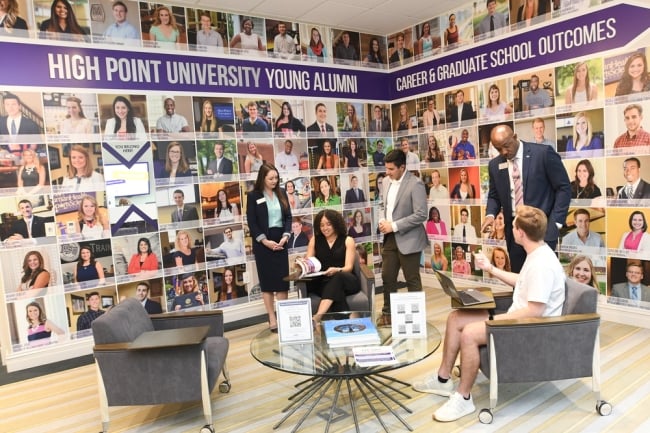You have /5 articles left.
Sign up for a free account or log in.

High Point University’s Office of Career and Professional Development has a central location on campus, near other offices and academic departments with which it frequently collaborates, according to Vice President Doug Hall.
High Point University
Given the rising cost of college and the vagaries of the job market, students and their families are more worried than ever about ensuring that a college degree leads to a successful career.
At least that’s the view of many colleges, which are increasingly boosting the profile—and resources—of their career centers, according to research by the National Association of Colleges and Employers. Of 287 career centers that reported their total budgets to NACE this past academic year, the median budget was $417,595, up from $330,357 in the 2019–20 academic year.
The 26.4 percent growth—which outpaced inflation over the same period—mainly reflects increases in personnel costs, which in 2018 made up a median of 81 percent of a career center’s total budget but now accounts for 88 percent. (The remaining 12 percent covers everything from office software to guest speaker fees.)
Joshua Kahn, associate director of research and public policy at NACE, said the increase in personnel costs reflects the current labor market, in which employers frequently need to offer higher wages and other benefits to attract workers.
At the same time, it shows that institutions are taking seriously the mounting concerns of students and their families about the return on a college investment.
“Students and parents have concerns about the costs of college and it’s fairly well known, well publicized, that getting a job and beginning their career is the main reason students go to college now. I think institutions are responding,” Kahn said.
Restructuring Career Services
Some universities are also rethinking the campus location of the career services office. Back when they were seen primarily as places for students to participate in mock interviews or have their résumés proofread, the offices were typically placed under the purview of student affairs. But now, as career centers expand their offerings and universities adjust how the centers fit into their larger mission, institutions are moving the centers to other locations, depending on how they function.
While student affairs remains the most popular home for career services, the share housed there has shrunk from 57.4 percent to 41.9 percent over the past decade, NACE found. But institutions that utilize academics to promote career-readiness—such as through a required class on job skills, for example—may be more inclined to place the career center in their academic affairs unit; according to NACE, that’s the second most common model, used by 25.2 percent of institutions. And at a college that uses student career outcomes as a marketing tool for prospective students, career services may be connected to admissions.
“It’s an educational unit to the students, a service unit to the employers and a revenue-generating unit,” said Andy Chan, vice president of innovation and career development at Wake Forest University in North Carolina. Chan was one of the first career-development officials to serve on a university president’s cabinet—a move he said made waves at the time he joined, in 2009. Since then, the university has become a leader in career services, launching a series of summer open houses to teach other institutions how to mimic key elements of its program, including building relationships with parents who are also employers—and who might hire recent graduates.
According to NACE, the share of institutions that have appointed a vice president of workforce development to lead their career centers has doubled to 2.4 percent since the organization began including the category in 2019–20. And just over 3 percent of institutions include that position in the office of president, like Wake Forest.
Chan said his role as a cabinet member gives the work of the university’s Office of Personal and Career Development credibility and weight—and helps create a feeling that career preparedness is integral to the university’s mission and identity. At the same time, it encourages the office to hold itself to the highest possible standard.
“The career office has to do great work and create great outcomes and satisfied constituents,” he said.
Kahn agreed that proximity to the university’s top decision-makers can be a game changer for career services offices.
“If the president wants a change made, the change is going to get made, so if they’re reporting directly to his office, they have a closer, stronger relationship with the president and they can get more resources,” he said. “If it becomes a presidential priority, they’re going to have more of an ability to get what they want.”
Linking career services to other offices can also build internal synergy.
At High Point University in North Carolina, the Office of Career and Professional Development reports to a senior vice president who also oversees the Office of Global Education and the Office of Student Success. The structural—and physical, as all three offices are located in the same building—closeness among these offices has led to increased opportunities for collaboration and innovation, said Doug Hall, vice president of career and professional development.
“We serve within an ecosystem of career development,” he said.
At both High Point and Wake Forest, such changes seem to be paying off; High Point’s 2022 graduating class boasted a 98.9 percent job-placement rate within 180 days of graduation, while Wake Forest’s job-placement rate has remained at 97 percent every year for nearly a decade.







.jpg?itok=QW-IeiPc)